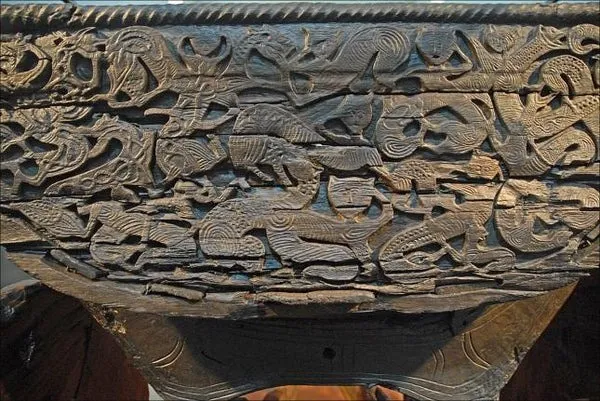The only complete Viking Age wagon. Found in a burial mound in Oseberg near the Oslo Fjord in Norway, 9th century AD.
One of the most interesting Viking excavation should be the Oseberg burial mound. Because it is a Viking ship burial, a very luxurious Viking ship burial indeed. Moreover, it was dedicated to two Viking women: one died around her 70s and the other around her 40s. Besides the large and well-preserved ship, the burial mound included many unique artifacts.

One of the most mysterious Oseberg artifacts also includes the Oseberg cart with subtle decoration. But what is the purpose of the Oseberg cart?
The Oseberg cart, according to the archaeologists, came into shape many years before the Oseberg ship. Archaeologists found exactly the same carts in parts of Denmark and Germany. And they were found in the luxurious graves of the wealthy women.
The Oseberg cart was as long as 5.5 meters (18ft) including the shafts. It was about 1.5 meters (5ft) in width and 1.2 meters (4ft) in height.
Like the Oseberg ship, the Oseberg cart had many subtle decorations on it. It depicts animals, symbols, humans, and especially cats. One common interpretation of this is that it attempted to depict Frey’s cats that pulled Freya’s wagon and other parts of the ceremony.

One of the subtle decorations of the Oseberg cart in the back: cats, symbols, human, and animals
The carving from the front showed a man fighting with snakes and a beast was biting his foot. Seemingly, it depicts the myth of Gunnar in the snake pit.
The scene in the middle of the right side might depict the legendary tale of Freyr god of fertility and Gerd giantess of coldness.

Oseberg cart a man was included for scale
This cart was carefully made with many types of materials. The shafts came from the ash. The upper board was made of oak tree. The archaeologists guessed that the cart was pulled by two horses.
For each part of the wagon could be dismantled so the Vikings were able to transport on the ship. When the ship was inshore, the servants would release the wagon and it could transport either the woman or the objects from the ship toward the land without much labour.






